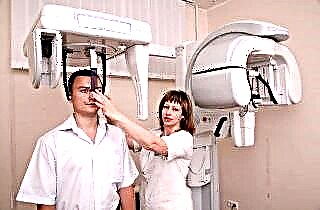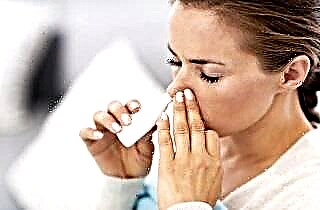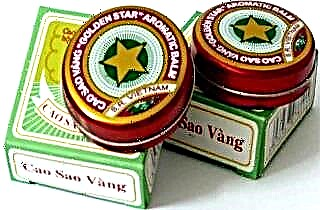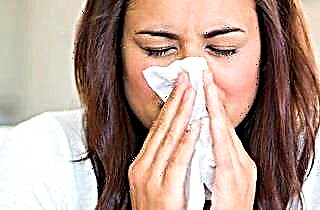If you find problems breathing through your nose, your head and the bridge of your nose occasionally hurt, then you most likely have bilateral sinusitis. We are talking about a pathological inflammatory process that affects 2 sinuses at the same time. This disease can be caused by fungal, bacterial and viral pathogens. They focus on the lining of the paranasal sinuses and create a focus of infection.
Bilateral sinusitis can last more than 2 months and cause severe discomfort. At first, sinusitis is an acute form with pronounced symptoms. Untimely or incorrect treatment transforms it into a chronic form with a latent course of the disease.
The main causes and symptoms of sinusitis
 Often, 2-sided sinusitis acts as a complication of the unilateral form of the disease. Among the factors provoking it are the following:
Often, 2-sided sinusitis acts as a complication of the unilateral form of the disease. Among the factors provoking it are the following:
- adenoids;
- acute rhinitis;
- chronic rhinitis;
- untreated ailments of the respiratory tract;
- curvature (deformation) of the nasal septum;
- infection with bacterial, viral and fungal pathogens;
- diseases of the teeth located in the upper jaw.
It should be noted that acute bilateral sinusitis is rare. It is distinguished by the pronounced severity of symptoms, the severity and duration of the course of the disease (the disease can last two or more months). So, what are the signs that accompany such a disease?
First of all, regular headaches should be noted, which intensify in the evening or when bending over. Intense pain sensations are localized in the paranasal sinuses, as well as in the frontal and temporal parts. Difficulty breathing through the nose begins due to congestion in both nostrils.
In addition, the patient complains of abundant discharge of clear mucus from the nose, the voice becomes nasal. Pains on palpation (feeling) of the maxillary sinuses are clearly distinguishable.
Diagnostics and therapy
Whatever the form of bilateral sinusitis (acute or chronic), qualified treatment under the guidance of doctors is required. That is why we recommend that at the first symptoms of such an ailment, seek professional help as soon as possible. This will significantly reduce the risk of dangerous complications. Before prescribing therapy, the doctor makes a diagnosis. The most effective methods are as follows:
 examination of the patient and taking anamnesis;
examination of the patient and taking anamnesis;- computed tomography of the area of the nose;
- nuclear magnetic resonance;
- Ultrasound of the paranasal sinuses;
- X-ray examination.
Based on the data obtained, an optimal strategy is drawn up, which guarantees effective treatment. The most commonly used drug therapy:
- Your doctor may prescribe topical use of drugs to narrow the blood vessels. They will help to quickly eliminate the swelling of the mucous membrane. For this, the following drugs are prescribed: "Otrivin", "Vibrocil", "Sanorin", "Naftizin" and others.
- To normalize body temperature (if it is elevated), antipyretic drugs are prescribed, as well as pain relievers ("Ibuprofen", "Aspirin", "Paracetamol" and so on).
To make the treatment more effective, such physiotherapy procedures as electrophoresis and UHF are connected. Surgical intervention, as a rule, is required quite rarely, when the drug effect has not had an effect.
Antibiotic therapy
Antimicrobial drugs are used when other drugs have proven ineffective and symptoms persist. Do not forget: it is not recommended to decide on your own which antibiotics to use. They are prescribed only by a doctor. The wrong choice of drugs is fraught with a worsening of the clinical picture and the appearance of serious complications.
The choice in favor of one or another group of antibiotics will be made only after diagnosing the patient and determining the root cause of sinusitis. The main goal of antibiotic therapy is to destroy the site of infection. Typically, the following drugs are prescribed to treat bilateral sinusitis:
 "Amoxicillin";
"Amoxicillin";- "Clavulant";
- "Aksetil";
- "Sulfamethoxazole";
- "Trimethoprim" and others.
In this case, do not forget about the duration of antibiotic exposure to the body. It should not exceed fourteen days from the start of admission. Otherwise, the intestinal microflora will be severely affected. And this will cause diarrhea, dysbiosis and other unpleasant consequences.
If antibiotic therapy is ineffective, the doctor prescribes the most radical method of treatment - surgery.
Surgical method
If the patient asked for help too late, or drug therapy was ineffective, puncture of the frontal or maxillary sinuses is performed. This procedure is required to reduce the excess pressure that affects the paranasal sinuses. Puncture allows you to restore the normal discharge of mucus, eliminate the accumulation of pus.
 In some cases, the puncture may not have the desired effect (the inflammatory process remains). Rinsing the nasal passages with special antibacterial solutions come to the rescue. Washing, like puncture, must be performed in a hospital. Self-medication in this case is contraindicated, since it only aggravates the course of the disease. If you do not consult a doctor and ignore the ailment for a long time, it transforms into more serious diseases:
In some cases, the puncture may not have the desired effect (the inflammatory process remains). Rinsing the nasal passages with special antibacterial solutions come to the rescue. Washing, like puncture, must be performed in a hospital. Self-medication in this case is contraindicated, since it only aggravates the course of the disease. If you do not consult a doctor and ignore the ailment for a long time, it transforms into more serious diseases:
- encephalitis;
- meningitis;
- thrombosis;
- osteomyelitis;
- purulent otitis media;
- purulent inflammation of the eyes.
Pay attention to your health, listen to the sensations. If you become regularly bothered by headaches, or a sudden rise in temperature, visit your doctor. It is possible that you have acute sinusitis.
Folk recipes
At the very beginning of the disease, when sinusitis is not running, it can be cured with remedies from the arsenal of traditional medicine. The most effective will be the following:
- Use steam inhalation based on boiled potatoes. After boiling, drain off any remaining water and place the pot on the stove. This will help remove any remaining liquid. It is necessary to breathe, completely covering the head with a towel. The duration of the procedure should not exceed 15-20 minutes.
 Zvezdochka is a good alternative to potatoes. This balm for inhalation is effective in treating bilateral sinusitis. In this case, the duration of the procedure is no more than 7-10 minutes. It is also recommended to add menthol and garlic when inhaled.
Zvezdochka is a good alternative to potatoes. This balm for inhalation is effective in treating bilateral sinusitis. In this case, the duration of the procedure is no more than 7-10 minutes. It is also recommended to add menthol and garlic when inhaled.- Warming up hard-boiled eggs helps a lot. Heated salt or sand will do. They should be wrapped in a thin towel and applied to the areas near the nose.
- Use a compress to reduce pain and discomfort. Tortillas are made from honey and rye flour.
- When there are no pharmacy drops on hand, regularly bury your nose with homemade aloe juice. The addition of honey and juice of freshly boiled beets will help to enhance the effectiveness of the medicine.
- If you are not worried about the pungent smell of garlic, you can prepare garlic drops. To do this, squeeze out a few drops of garlic juice and mix with olive oil. The agent is buried in the nose. Olive oil can be overly thick. In this case, apply the solution to the mucous membrane with a cotton swab.
- As for home washes with iodine, sage and other available remedies, they are also used to eliminate the symptoms of sinusitis. However, it is better not to perform such a procedure on your own: the likelihood of complications is high.
Prophylaxis
Of course, you cannot completely insure yourself against bilateral sinusitis. But you can significantly reduce the risk of this ailment by adhering to the following simple rules. Monitor your health and immunity. Start practicing hardening and contrast showers. This will maximize the body's resistance.
 The effective work of the immune system will allow the body to independently fight the viral infection. Do not forget to consume vitamins (especially in the autumn-winter period, when seasonal epidemics of flu and colds are rampant).
The effective work of the immune system will allow the body to independently fight the viral infection. Do not forget to consume vitamins (especially in the autumn-winter period, when seasonal epidemics of flu and colds are rampant).
If hardening is not for you, try not to overcool and avoid drafts. Always keep your feet warm and dress for the weather and the season. Minimize contact with people with colds.
Sinusitis can appear with some regularity. This means that their cause lies in the anatomical features (deviated nasal septum, and so on). In this case, the only reasonable solution is to visit the surgeon. Remember: you alone are responsible for your health. Therefore, take care of him, and then you will not be afraid of any sinusitis.

 examination of the patient and taking anamnesis;
examination of the patient and taking anamnesis; "Amoxicillin";
"Amoxicillin"; Zvezdochka is a good alternative to potatoes. This balm for inhalation is effective in treating bilateral sinusitis. In this case, the duration of the procedure is no more than 7-10 minutes. It is also recommended to add menthol and garlic when inhaled.
Zvezdochka is a good alternative to potatoes. This balm for inhalation is effective in treating bilateral sinusitis. In this case, the duration of the procedure is no more than 7-10 minutes. It is also recommended to add menthol and garlic when inhaled.

